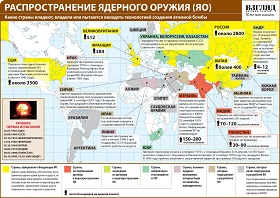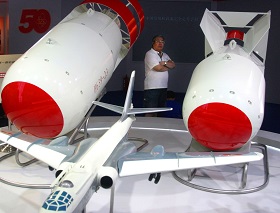Radical reduction of nuclear arms will strengthen Russia’s security
Nuclear weapon effects computer
(no votes) |
(0 votes) |
Head of the Department for Disarmament and Conflict Resolution Studies at the Primakov National Research Institute of World Economy and International Relations (IMEMO), Russian Academy of Sciences, Professor of MGIMO-University, RIAC Member
As the traditional strategic stability equation evolves and grows more complicated, it becomes harder, perhaps even impossible, to calculate the formula for further nuclear reductions by Russia and the United States. The goal of deep reductions of the nuclear weapons arsenals and that of maintaining Russia and the United States’ capacity for mutual assured destruction involve irreconcilable differences. It would be a grave error to assume that further nuclear arms reductions, especially given the advances made in modern weapons developments, are incompatible with the strengthening of Russia’s security.
In April 2008, the Presidents of Russia and the United States declared that the time had come to overcome the barriers of the strategic principles of the past, associated with the prospect of mutual annihilation, and focus on the real threats that our countries are facing [1]. Five years have passed and there has not been yet any real progress.
After the signing of a new Strategic Offensive Arms Reduction Treaty in 2010, talk about nuclear disarmament has bogged down in the arguments based on the idea that evolved during the Cold War i.e. that strategic stability rested on the capability of Russia and the United States to “mutually and in a guaranteed manner” annihilate each other. Not only further reductions of nuclear weapons but broader Russia–U.S. relations became hostage to this faulty logic.
With the advancement of modern warfare, maintaining strategic stability – understood as preserving the U.S. and Russia’s capability to destroy each other – is becoming an increasingly complex task. Today’s bilateral equation of “strategic stability” does not only include the two countries’ nuclear arms, but also the existing and theoretically possible future missile defense systems and conventional, i.e. non-nuclear long-range and high-precision weapons, and even the hypothetical deployment of space-based attack systems, to name but a few. The picture becomes even more complex when you factor in the nuclear arsenals of third countries, such as China, the UK, France, and sometimes even India and Pakistan.
As the traditional strategic stability equation evolves and grows more complicated, it becomes harder, perhaps even impossible, to calculate the formula for further nuclear reductions by Russia and the United States. The goal of deep reductions of the nuclear weapons arsenals and that of maintaining Russia and the United States’ capacity for mutual assured destruction involve irreconcilable differences. There is a growing feeling that the capacity for further reductions has been exhausted, if not reached its limit, should we follow the former logic of maintaining strategic stability. It would be a grave error to assume that further nuclear arms reductions, especially given the advances made in modern weapons developments, are incompatible with the strengthening of Russia’s security.
Russia and the U.S. can come out of this deadlock if they return to the task set by the Presidents in 2008 – renouncing the “strategic principles” of the “Cold War.” Under this imperative they could launch an initiative to start the phased elimination of all long-range land-based ballistic missiles in the world. As a result, an entire class of nuclear missiles would be destroyed. This initiative, if implemented, would substantially enhance another of Russia’s proposals – to make the 1987 Russia-U.S. Treaty on the Elimination of the Intermediate- and Shorter-range Missiles (INF Treaty) universal. As a first step, Russia and the U.S. could set an example to other countries by agreeing to reduce their intercontinental ballistic missiles (ICBMs).
If this proposal is implemented, Russia would not only be able to make a breakthrough and substantially strengthen its relations with the United States. This would mean Russia gets to enhance its own security but also score real progress in numerous areas, such as:
- Re-taking its position as global leader in strengthening international security;
- De-fusing the debate about a raft of sensitive issues, including U.S. global missile defense;
- Making the first step toward expanding the dialogue on nuclear arms reduction and engaging nuclear powers, including China in it;
- Enhancing the prospects for strengthening the international nuclear non-proliferation regime during the 2015 NPT Review Conference;
- Retaining significant (increasingly hard to obtain) budget funds;
- Promoting other Russian initiatives on international security, including proposals to make understandings with the United States on the elimination of intermediate- and shorter-range missiles universal;
- Helping secure progress in other areas of arms control, particularly on issues related to conventional arms control in Europe.
“Strategic Stability” Deadlock
The understanding of strategic stability that formed over the last two decades of the Cold War was based on the assumption that the “opposing sides,” i.e. the U.S. and Russia, were preparing to launch a massive nuclear strike against each other’s strategic offensive weapons and command systems. Under those circumstances, the decisive role in maintaining strategic stability or deterring the opposite side was to ensure the survival of one’s own nuclear forces, guaranteeing the imminent annihilation of the aggressor by a “response” retaliation strike.
The parties’ approach to building their offensive and defensive forces, and negotiations on their reduction and limitation, have long been rooted in the simulation of potential first-strike and retaliatory strike scenarios. During the Cold War, this led to a situation in which the Soviet and U.S. strategic nuclear forces were preparing to launch a retaliation attack before their missiles could be destroyed by a massive strike from the opposing side. The mechanism of this “mutually assured destruction,” which was actually automatic, left the two countries’ leaders with no time to assess the situation and make a well thought-through political decision. Space- or land-based early warning missile attack signals were supposed to trigger the retaliation strike. There were just a few minutes between the detection of an enemy missile launch and the command to retaliate.
During the Cold War, this logic saw U.S. and Russian national security become a hostage to technical failure. An accidental or unauthorized launch of the systems involved, or any failure in the early warning systems, could set off a chain reaction and lead to an irreparable result – the mutual guaranteed annihilation of Russia and the U.S. There were situations in which, even during the years of close cooperation, technical failure took the two countries to the brink of trading nuclear strikes, despite the will of the Russian and U.S. leadership, whereas the number of nuclear warheads remaining in the possession of Russia and the United States was not that important. What mattered was to launch the machinery of retaliation in time.
No other nuclear state has ever made its political decision-making process over the use of nuclear weapons dependent on the technology. Until the 1970s, the United States and the USSR based their policy of mutual nuclear deterrence on different principles: they were not pursuing a goal of automatic mutual annihilation. Why then is it believed to be an absolute truth that they should maintain this mutually assured destruction (MAD) capability today?
There are no 'ifs' in history. There is no point in debating whether this MAD policy was the best possible option for maintaining strategic stability between the USSR and the United States during the Cold War, or whether there was a more reasonable alternative. With the end of the Cold War, when the two sides believe that the probability of nuclear confrontation between them is negligible, it is increasingly dangerous to rely on MAD, which is not just a relic of the past. Policies that are hostage to this erroneous logic find it increasingly difficult to break this vicious circle.
Today, Russia and the United States are no longer engaged in a global struggle based on the principle of "who will beat whom." So, from the point of view of national security, cocking the nuclear gun against one’s opponent’s temple, ready to fire it at the slightest suspicious move, is now both meaningless and unproductive. This represents an even greater risk when the development of modern non-nuclear military technologies can trigger a "retaliation" strike if the early warning systems send an alarm signal in response to a missile launch (not necessarily nuclear) by another side, quite apart from accidental or unauthorized launches.
All this raises a question not only about the number of nuclear weapons Russia and the U.S. really need, but also about the very principle of accounting for them. Neither Russia nor the U.S. today requires MAD potential, although it is clear that they continue to deem it necessary to maintain a limited mutual nuclear deterrence potential for quite a while.
Abandoning the Intercontinental Ballistic Missiles

The Paradoxes of Global Zero
It is not that easy to dismantle the mechanisms of mutually assured destruction, in part due to the inertia of the military and technical thinking. In recent decades a great many useful ideas have been proposed and discussed regarding the steps that need to be taken in order to gradually abandon this principle and dismantle its material basis. One of these proposals involves the verified reduction in the level of combat readiness of the two countries’ strategic nuclear systems, which has been carefully developed by Russian and American experts and politicians. This would allow the two sides not only to disarm the trigger but also to put the safety-lock on and gradually move away from planning this automatic massive response strike.
We believe it is possible to make a meaningful step forward toward abandoning the logic of mutual assured annihilation in our relations with the United States, including radical reduction, and ideally the total elimination of ICBMs and reaching agreement among all nuclear countries on the elimination and comprehensive ban on the development, testing and deployment of long-range ballistic missiles.
The rationale behind this decision is easy to understand. In fact, land-based ballistic missiles (chiefly the heavy MIRVed missiles), are considered the most likely first strike weapon. They are more vulnerable than SLBMs and, therefore, they are supposed to be launched before another side destroys them (whether by nuclear or non-nuclear weapons). For the same reason, it is precisely the ICBMs that "attract" the first strike from the opposing side and force it to calculate the options for their destruction and/or neutralization using missile defense systems.
The radical reduction and ultimate elimination of U.S. and Russian ICBMs will help reverse this rationale. The systems that most destabilize the mutual strategic equation will be eliminated. There will be no more need to plan the first strike against the ICBM deployment sites and launch retaliatory strikes immediately after receiving the signal from one’s own early warning systems.
As long as Russia and the U.S. do not rule out the need to maintain a reasonable potential for mutual nuclear deterrence at reduced levels without preparing for mutually assured destruction, the task of deterrence could be fulfilled by strategic sea-based systems. These systems are the least vulnerable to the first strike and serve as a guarantee that Russia and the U.S. will maintain sufficient leverage in the last resort if they return to confrontation (which is highly improbable).
The radical reduction and elimination of ICBMs would help mitigate the missile defense issue in the strategic balance between Russia and the U.S. since the two sides would abandon the missiles that the missile defense systems would intercept.
This decision would also help avoid the potential development of non-nuclear long-range high precision systems which could theoretically be used to strike the ICBM silo launchers, as these targets would no longer exist.
This would help disentangle the problems that continue to complicate and overburden the strategic stability equation and prevent further nuclear arms reductions. This will only contribute to Russia's security.
As a result, the Russian government will be able to save a significant part of its budget. Indeed, maintaining strategic nuclear forces at the numeric levels agreed upon with the U.S. under the New START Treaty implies the deployment of new ICBMs rather than the old decommissioned ICBMs. An important part of the modernization program – the development of a new heavy ICBM with multiple reentry vehicles – seems more than an arguable decision, even in the context of a traditional definition of strategic stability in Russian-American relations. The case in point is that these missiles are the most destabilizing factor in mutual balance, and due to their vulnerability they can be used primarily as a first strike weapon against the enemy.
The agreement on radical reduction and the global elimination of long-range nuclear missiles would allow Russia to spare the enormous resources spent on developing, deploying and eliminating such missiles.
Other Nuclear Powers
Today, when Russia and the U.S. possess more than 90 percent of all the world’s nuclear arsenals, it would be a dangerous illusion to expect other nuclear countries to agree to negotiate to reduce or limit their potentials. It is important to recognize that Russia and the U.S. have a way to go in dealing with "their backlog" to continue bilateral nuclear arms reductions. The question is different: How can we address these reductions in a way that incentivizes other nuclear powers and engage them in a relevant dialogue and later eventual negotiations?
Together with the announcement of the plans relating to the radical reduction of ICBMs in the two countries, the Presidents of Russia and the U.S. could propose to other nuclear countries to start a dialogue on a potential global ban on and elimination of long-range ballistic missiles at a later stage. This issue can be raised for discussion within the framework of the regular meetings of the "big five" – nuclear powers and permanent members of the UN Security Council (Russia, the United States, the UK, China and France).
The three other permanent members of the UNSC should not be expected to give a positive answer immediately. However, the idea of abandoning land-based ballistic missiles should not pose a problem for France or Britain, since they do not possess these weapons. Even if they are not currently prepared to engage in substantial negotiations and make the relevant treaty commitments, they could respond positively to a Russian-American initiative. They could, for example, declare that they do not possess land-based ballistic missiles or plans to deploy them.
The four nuclear powers’ positive response to the idea of abandoning the ICBMs could not but influence China’s leadership position, if it turns out to be the only member of the "big five" that rejects the idea. This would lend a momentum that could help launch a dialogue among the five nuclear powers at the initial stage, bearing in mind that a more specific understanding would be reached in the future.
A declaration by Russia and the United States regarding their readiness to start a radical reduction and, in the longer term, the total elimination of ICBMs would substantially reinforce the arguments in favor of the Russian initiative to make the 1987 Treaty on the Elimination of Intermediate- and Shorter-Range Missiles universal.
The broader initiative proposed by Russia and the U.S. on the further reduction of their nuclear forces, with the prospect of engaging other nuclear powers in this process, would significantly strengthen the position of the proponents of a nuclear non-proliferation regime at the forthcoming NPT Review Conference.
Broadly, this initiative would strengthen the national security of both Russia and the U.S., and would also enhance Russian-American joint efforts in areas that are crucially important to them, while also making a significant contribution to strengthening international security more broadly.
There Are No Ideal Solutions
This proposal may spark criticism in Russia and abroad. That is only natural. There are no ideal solutions. The game of nuclear war brinkmanship between Russia and the U.S. was itself not an ideal solution (nor is it one today). The critical discussion of the idea of the radical reduction and elimination of long-range land-based ballistic missiles will help compare the strengths and weaknesses in Russia's nuclear policy and to examine this proposal more thoroughly to compensate for its potential shortfalls.
1. The Declaration that set out a framework of strategic cooperation between the United States and Russia; Sochi, April 2008. See http://archive/kremlin/ru/text/docs/2008/04/163171/shtml
(no votes) |
(0 votes) |






